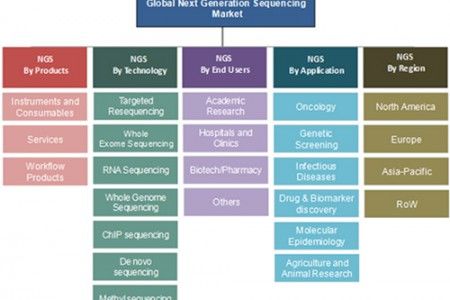Sequencing technology has experienced a very long time, the next generation sequencing (NGS) radically change the way the human genomes are sequenced.IQ4I Research & Consultancy analysis suggests that global NGS market is expected to reach $4.892 billion by 2020 at a CAGR (a compound annual growth rate) of 20.7%. Among the global NGS market, instruments and consumables are the largest segment, accounting for almost half of the market in 2013. The fastest growing part is services with a CAGR of more than 20%.
According to experts, the cost of the human genome sequencing will be $1000 and the result will arrive in one to two days in the coming years. Since the implementation of the first human genome sequencing, the costs and time required for genome sequencing has been greatly reduced. The advancement of NGS technology opens a new window for clinical diagnosis.
IQ41 report provides market revenue and key volume analysis of NGS sample runs through various technologies, platforms, and end users/laboratories.
The lower cost and higher speed of NGS technology has increased its use in the clinical segment, that fact as well as the growth of personalized medicine, increased medical expenditure, and shift from microarrays to NGS are driving the NGS market to grow. However, the outlook is not entirely optimistic, problem areas involve standardization and accuracy of NGS procedures, complexity in data interpretation and storage, shortage of skilled labor, and dependence on grants and funding for NGS infrastructure.
The global NGS market is divided into targeted re-sequencing, whole exome sequencing, RNA sequencing, whole-genome sequencing, ChIP sequencing, de novo sequencing, and methylation sequencing. Among these, targeting re-sequencing accounts for the largest share, and the fastest growing one is whole-genome sequencing (a CAGR of more than 25%). Targeted re-sequencing and whole-genome sequencing technologies have great promise as various targeted disease-based NGS assays and panels are emerging.
According to the report IQ4I, academic researchers are the main NGS end users, accounts for about 60% share of the market. Hospitals and clinics have higher CAGR, whose market share by 2020 is expected to increase more than 40%. In addition, the rising demand and the increasing application in the clinical field is forecast to drive the market at the highest CAGR for a share of 25% by 2020.
By the application type, NGS market is segmented into oncology, genetic screening, infectious diseases, drug and biomarker discovery, agriculture, molecular epidemiology and other applications. In all these applications, oncology occupies the largest market share (over 35%) in terms of revenue and sample volume.
In terms of the regional differences, North America is the largest share-holder of the global NGS market, accounting for $571 million. Asia-Pacific is the fastest growing region with the highest CAGR. The major players operating in the NGS market are Illumina, Hoffmann-La Roche, Thermo Fisher, Agilent Technologies, Pacific Biosciences, Biomatters, BGI, Qiagen, and Genomatix Software. Illumina is the leader in the NGS market followed by Hoffmann-La Roche and Thermo Fisher and these companies together hold a market share of more than 90%.


 Sample Submission Guidelines
Sample Submission Guidelines
